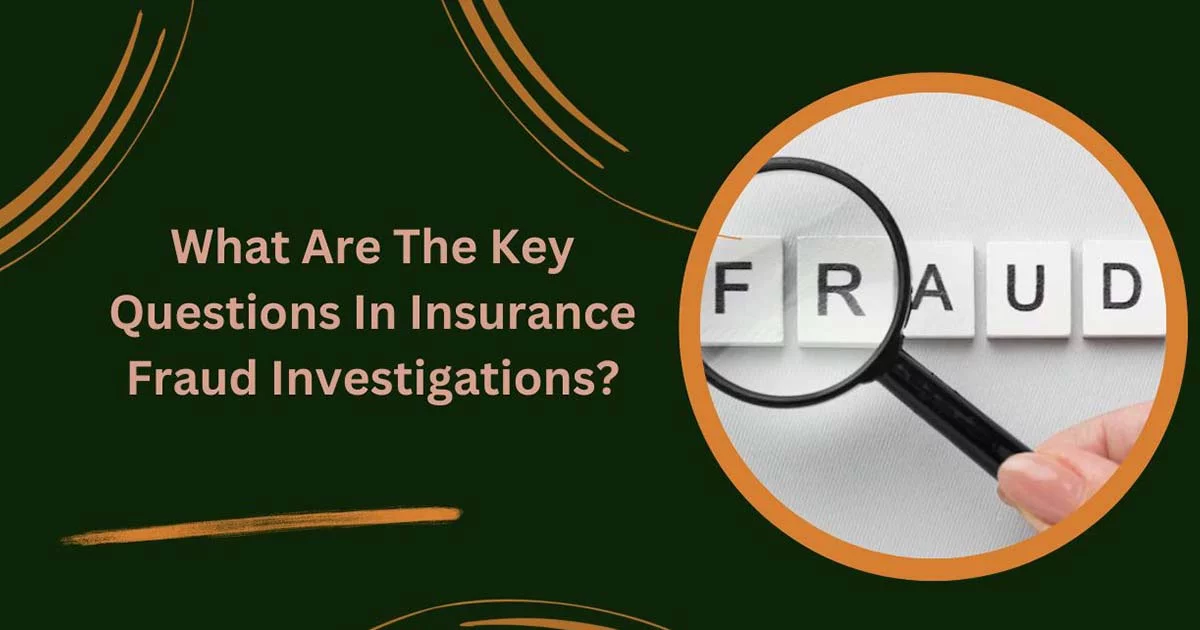Insurance fraud is a pervasive issue that affects the insurance industry &, ultimately, the average policyholder. In the United States alone, it is estimated that insurance fraud costs the industry billions of dollars annually, leading to higher premiums for all policyholders. To combat this problem, Insurance companies, law enforcement agencies, & private investigators employ a range of methods to detect and investigate fraudulent claims. At the heart’s of these efforts are a series of key questions that must be asked & answered to uncover the truth and bring perpetrators to justice.
Is There A Motive?
One of the first questions investigators consider in an insurance fraud case is whether there is a clear motive for the policyholder to commit fraud. Understanding Why someone might want to defraud an Insurance company can shed light on the likelihood of a fraudulent claim. Common motives include financial distress, a desire for a quick cash payout, or a history of previous fraudulent claims.
What Does The Evidence Reveal?
Gathering and analyzing evidence is a fundamental step in any insurance fraud investigation. Investigators assess the documents, photographs, videos, and witness statements related to the claim. They look’s for inconsistencies, omissions, or discrepancies that could point to fraud. This evidence may include damage assessments, medical records, and the claimant’s financial history.
Are There Any Inconsistencies In The Claimant’s Statements?

During an insurance fraud investigation, one of the critical tasks is scrutinizing the statements made by the claimant. Are there inconsistencies or contradictions in their account of the events leading up to the claim? Such discrepancies can be a red flag and warrant further investigation.
Does The Claimant Have A history Of Fraudulent Claims?
Another important Question is whether the claimant has a history of making suspicious or Fraudulent claims. Insurance companies maintain databases of claim histories, and investigators often check these records to identify patterns or recurring claimants. A history of suspicious claims can raise the likelihood of fraud in the current case.
Were There Any Witnesses To The Incident?
In cases involving accidents or property damage, The presence of witnesses can Provide valuable Tnformation. Investigators seek out and interview potential witnesses to gather their accounts of the incident. Witness statements can corroborate or contradict the claimant’s version of events.
Was The Incident Properly Reported To The Authorities?

The timely reporting of an incident to The relevant Authorities, such as the police in the case of an accident or theft, is a crucial factor in The determining the legitimacy of a Claim. Delays in reporting can raise suspicion, as they may indicate an attempt to manipulate the circumstances to support a fraudulent claim.
Are There Signs Of Pre-existing Damage Or Prior Incidents?
Inspecting the damage or losses claimed in detail is essential. Investigators look for signs of pre-existing damage or evidence of prior incidents that may not have been Reported. Such discoveries can indicate that the claimant is attempting to attribute pre-existing issues to a recent incident to receive compensation.
Is The Medical Treatment Consistent With The Alleged Injuries?
In cases involving bodily injury claims, investigators assess whether the medical treatment received by the claimant is consistent with the reported injuries. Overly aggressive or unnecessary medical treatment can be a sign of insurance fraud.
Are There Connections To Known Fraud Rings Or Criminal Organizations?
Insurance fraud often involves organized groups or networks of criminals working together to defraud insurance companies. Investigating any potential connections to known fraud rings or criminal organizations is crucial. Such connections can help uncover broader criminal activities.
Are There Financial Red Flags?

A close examination of the claimant’s financial history is another important aspect of insurance fraud investigations. Investigators look for signs of financial distress or unusual transactions that may suggest an ulterior motive for filing a fraudulent claim.
Has The Claimant Engaged In Post-claim Fraud?
Sometimes, claimants who initially file legitimate claims later attempt to inflate their losses or make false additional claims. Investigators must watch for signs of post-claim fraud, which can complicate the resolution of an otherwise valid claim.
Has The Claim Been Properly Documented?
Documentation is key in insurance claims. Investigators assess whether the claim has been thoroughly documented with all required information and supporting evidence. Incomplete or inconsistent documentation can raise suspicions.
Can The Claimant Provide A Clear And Consistent Timeline Of Events?
A clear and consistent timeline of events leading up to the claim is essential. Investigators evaluate whether the claimant can provide a logical sequence of events without contradictions or omissions. Inconsistencies in the timeline can indicate potential fraud.
Are There Any Surveillance Videos Or Photos?

Surveillance footage can be a powerful tool in insurance fraud investigations. Insurers often employ private investigators to capture video or photographic evidence to corroborate or refute the claimant’s account of events.
Is There A Pattern Of Similar Claims Within A Specific Area Or Demographic?
Insurance companies use data analysis to identify patterns and trends in claims. A cluster of similar claims within a specific area or demographic can be indicative of organized fraud or fraud rings operating in that region.
Also Read : What Every Worker Needs To Know About Employment Insurance
Conclusion
Insurance fraud is a pervasive problem that poses a significant challenge to the insurance industry. Detecting and investigating fraudulent claims require a keen eye for detail, a methodical approach, and a series of key questions that guide investigators. By asking these questions and thoroughly analyzing the evidence, insurance companies and law enforcement agencies can uncover fraud, protect the interests of honest policyholders, and bring those who commit insurance fraud to justice. While insurance fraud may persist, a relentless commitment to investigation and vigilance can help mitigate its impact and maintain the integrity of the insurance industry.
FAQs
1. What are the primary motivations for insurance fraud?
Insurance fraud perpetrators often have clear motives such as financial gain, covering pre-existing damage, or exploiting an opportunity for a quick payout. These motivations are a fundamental consideration in fraud investigations.
2. How do investigators determine if a claimant is committing fraud?
Investigators assess the evidence, such as damage assessments, witness statements, and financial records. They also scrutinize the consistency of the claimant’s statements and look for any inconsistencies or patterns of fraudulent behavior.
3. Why is it important to check for prior claims history?
Checking a claimant’s history of insurance claims is crucial because a pattern of suspicious or fraudulent claims can raise the likelihood of fraud in the current case. It provides insight into the claimant’s behavior and credibility.
4.What role does evidence play in insurance fraud investigations?
Evidence is at the heart of any insurance fraud investigation. It includes documents, photographs, videos, and witness statements. Investigative teams carefully analyze this evidence to determine whether it supports or contradicts the claimant’s case.
5.Are there common signs that might indicate insurance fraud?
There are several red flags that investigators look for, including inconsistencies in statements, delays in reporting incidents to authorities, pre-existing damage or prior incidents, connections to known fraud rings, and financial distress. These signs can suggest potential fraudulent activity and warrant further investigation.
Source Image : Freepik





